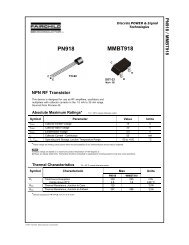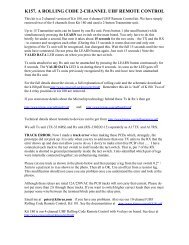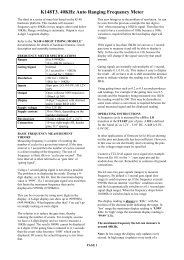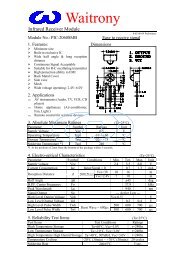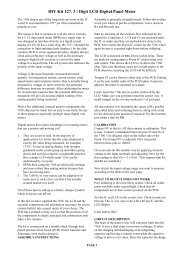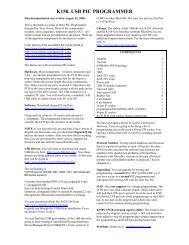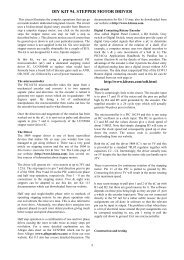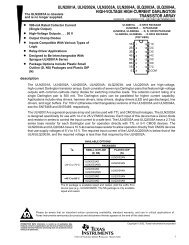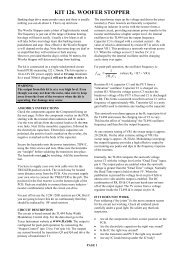Kit 7. 3V FM TRANSMITTER - PAiA
Kit 7. 3V FM TRANSMITTER - PAiA
Kit 7. 3V FM TRANSMITTER - PAiA
You also want an ePaper? Increase the reach of your titles
YUMPU automatically turns print PDFs into web optimized ePapers that Google loves.
<strong>Kit</strong> <strong>7.</strong> <strong>3V</strong> <strong>FM</strong> <strong>TRANSMITTER</strong><br />
This <strong>FM</strong> transmitter (<strong>FM</strong> Tx) is about the simplest and<br />
most basic <strong>FM</strong> Tx it is possible to build and have a useful<br />
transmitting range. It is surprisingly powerful despite its<br />
small component count and <strong>3V</strong> operating voltage. It will<br />
easily penetrate over three floors of an apartment building<br />
and go over 300 meters in the open air.<br />
The circuit we use is based on a proven Australian design.<br />
It may be tuned anywhere in the <strong>FM</strong> band. Or it may be<br />
tuned outside the commercial M band for greater privacy.<br />
(Of course this means you must modify your <strong>FM</strong> radio to<br />
be able to receive the transmission or have a broad-band<br />
<strong>FM</strong> receiver.)<br />
The output power of this <strong>FM</strong> Tx is below the legal limits<br />
of many countries (eg, USA and Australia). However,<br />
some countries may ban ALL wireless transmissions<br />
without a licence. It is the responsibility of the purchaser<br />
to check the legal requirements for the operation of this kit<br />
and to obey them.<br />
The kit is constructed on a single-sided printed circuit<br />
board (PCB). Protel Autotrax was used to design the<br />
board.<br />
ASSEMBLY INSTRUCTION<br />
Components may be added to the PCB in any order. Note<br />
that the electret microphone should be inserted with the<br />
pin connected to the metal case connected to the negative<br />
rail (that is, to the ground or zero voltage side of the<br />
circuit). The coil should be about 3mm in diameter and 5<br />
turns. The wire is tinned copper wire, 0.61 mm in diameter.<br />
After the coil in soldered into place spread the coils apart<br />
about 0.5 to 1mm so that they are not touching. (The<br />
spacing in not critical since tuning of the Tx will be done<br />
by the trim capacitor. It is quite possible, but not as<br />
convenient, to use a fixed value capacitor in place of the<br />
trimcapacitor - say 47pF - and to vary the Tx frequency by<br />
simply adjusting the spacing of the coils. That is by<br />
varying L of the LC circuit rather than C.) Adding and<br />
removing the batteries acts as a switch.<br />
Connect a half or quarter wavelength antenna (length of<br />
wire) to the aerial point. At an <strong>FM</strong> frequency of 100 MHz<br />
these lengths are 150 cm and 75 cm respectively.<br />
CIRCUIT DESCRIPTION<br />
The circuit is basically a radio frequency (RF) oscillator<br />
that operates around 100 MHz. Audio picked up and<br />
amplified by the electret microphone is fed into the audio<br />
amplifier stage built around the first transistor. Output<br />
from the collector is fed into the base of the second<br />
transistor where it modulates the resonant frequency of<br />
the tank circuit (the 5 turn coil and the trimcap) by varying<br />
the junction capacitance of the transistor. Junction<br />
capacitance is a function of the potential difference<br />
applied to the base of the transistor. The tank circuit is<br />
connected in a Colpitts oscillator<br />
circuit. Let us look at the individual blocks of the circuit<br />
more closely:<br />
The electret microphone: an electret is a permanently<br />
charged dielectric. It is made by heating a ceramic material,<br />
placing it in a magnetic field then allowing it to cool while<br />
still in the magnetic field. It is the electrostatic equivalent<br />
of a permanent magnet. In the electret microphone a slice<br />
of this material is used as part of the dielectric of a<br />
capacitor in which the diaphram of the microphone forms<br />
one plate. Sound pressure moves one of its plates. The<br />
movement of the plate changes the capacitance. The<br />
electret capacitor is connected to an FET amplifier. These<br />
microphones are small, have excellent sensitivity, a wide<br />
frequency response and a very low cost.<br />
First amplification stage: this is a standard self-biasing<br />
common emitter amplifier. The 22nF capacitor isolates the<br />
microphone from the base voltage of the transistor and<br />
only allows alternating current (AC) signals to pass.<br />
The tank (LC) circuit: every Tx needs an oscillator to<br />
generate the radio Frequency (RF) carrier waves. The tank<br />
(LC) circuit, the BC547 and the feedback 5pF capacitor are<br />
the oscillator in the Cadre. An input signal is not needed<br />
to sustain the oscillation. The feedback signal makes the<br />
base-emitter current of the transistor vary at the resonant<br />
frequency. This causes the emitter-collector<br />
current to vary at the same frequency. This signal fed to<br />
the aerial and radiated as radio waves. The 27pF coupling<br />
capacitor on the aerial is to minimise the effect of the aerial<br />
capacitance on the LC circuit.<br />
The name 'tank' circuit comes from the ability of the LC<br />
circuit to store energy for oscillations. In a pure LC circuit<br />
(one with no resistance) energy cannot be lost. (In an AC<br />
network only the resistive elements will dissipate electrical<br />
energy. The purely reactive elements, the C and the L<br />
simply store energy to be returned to the system later.)<br />
Note that the tank circuit does not oscillate just by having<br />
a DC potential put across it. Positive feedback must be<br />
provided. (Look up Hartley and Colpitts oscillators in a<br />
reference book for more details.)<br />
CIRCUIT CALIBRATION<br />
Place the transmitter about 10 feet from a <strong>FM</strong> radio. Set<br />
the radio to somewhere about 89 - 90 MHz. Walk back to<br />
the Fm Tx and turn it on. Spread the winding of the coil<br />
apart by approximately 1mm from each other. No coil<br />
winding should be touching another winding. Use a small<br />
screw driver to tune the trim cap. Remove the screwdriver<br />
from the trim screw after every adjustment so the LC<br />
circuit is not affected by stray capicitance. Or use a plastic<br />
screwdriver. If you have difficulty finding the transmitting<br />
frequency then have a second person tune up and down<br />
the <strong>FM</strong> dial after every adjustment.<br />
One full turn of the trim cap will cover its full range of<br />
capacitance from 6pF to 45pF. The normal <strong>FM</strong> band tunes
<strong>Kit</strong> <strong>7.</strong> <strong>3V</strong> <strong>FM</strong> <strong>TRANSMITTER</strong><br />
in over about one tenth of the full range of the tuning cap.<br />
So it is best to adjust it in steps of 5 to 10 degrees at each<br />
turn. So tuning takes a little patience but is not difficult.<br />
The reason that there must be at least 10 ft. separation<br />
between the radio and the Tx is that the Tx emits<br />
harmonics; it does not only emit on one frequency but on<br />
several different frequencies close to each other.<br />
You should have little difficulty in finding the Tx<br />
frequency when you follow this procedure.<br />
WHAT TO DO IF IT DOES NOT WORK<br />
Poor soldering is the most likely reason that the circuit<br />
does not work. Check all solder joints carefully under a<br />
good light. Next check that all components are in their<br />
correct position on the PCB. Thirdly, follow the track with<br />
a voltmeter to check the potential differences at various<br />
parts of the circuit particularly across the base, collector<br />
and emitter of the two transistors.<br />
Are the transistors in the correct way. Is the battery flat.<br />
Check the collector-emitter voltages (1.0 to 1.5 V). This<br />
will tell you that the battery potential difference is across<br />
those components.<br />
It is possible that due to variations in tolerance the 22K<br />
load resistor of the microphone may have to be increased<br />
or decreased to get the best response. Reducing the value<br />
will increase the sensitivity.<br />
WHAT TO LEARN FROM THIS KIT<br />
It should already be clear from the above circuit<br />
description that there is a surprising amount of electronics<br />
which may be learnt from this deceptively simple kit. Here<br />
is a list of some advanced topics in electronics which can<br />
be demonstrated or have their beginnings in this kit: Class<br />
C amplifiers; <strong>FM</strong> transmission; VHF antennas; positive<br />
and negative feedback; stray capacitance; crystal-locked<br />
oscillators; signal attenuation<br />
The simple halfwave antennae used in the kit is not the<br />
most efficient. Greater efficiency may be gained by<br />
connecting a dipole antennae using 50 ohm coaxial cable.<br />
Connect one lead to the Anrenna point and the other to<br />
the earth line.<br />
Note that this Tx is not suitable for use on your body, for<br />
example, in your pocket. This is because it is affected by<br />
external capacitance and the transmitting frequency drifts<br />
depending how close you are to it. Stray capacitance is<br />
automatically incorporated into the capacitance of the tank<br />
circuit which will shift the transmitting frequency.<br />
COMPONENTS<br />
Resistors (carbon, 0.25W, 5%):<br />
1M (brown, black, green 1<br />
47K yellow, violet, orange 1<br />
22K red, red, orange 1<br />
10K brown, black, orange 1<br />
470R yellow, violet, brown 1<br />
Capacitors:<br />
1n ceramic 102 1<br />
5p6 ceramic 1<br />
22n (223) ceramic 2<br />
27p ceramic 1<br />
100n monoblock 1<br />
BC547, 548 2<br />
5 turn coil 1<br />
Electret microphone 1<br />
Trimcap yellow (6-45pF) 1<br />
Aerial wire<br />
165cm<br />
<strong>Kit</strong> PCB 1<br />
2 AA battery holder 1<br />
For other Fm Tx see out <strong>Kit</strong>s 18 and 32. See them on our<br />
website at<br />
http://kitsrus.com<br />
For the detailed electrical theory of how Fm Tx like this<br />
one work see a z1.2MB zipped file you can download at<br />
http://kitsrus.com/zip/fmtx.zip<br />
For references to many other sites with Fm Tx’s see<br />
http://members.tripod.com/~transmitters<br />
You may experiment with using 6V or 9V with the circuit to<br />
see how this increases the range of the transmitter. The<br />
sensitivity may be increased by lowering the 22K resistor<br />
to 10K. Try it and see.
<strong>Kit</strong> <strong>7.</strong> <strong>3V</strong> <strong>FM</strong> <strong>TRANSMITTER</strong>



